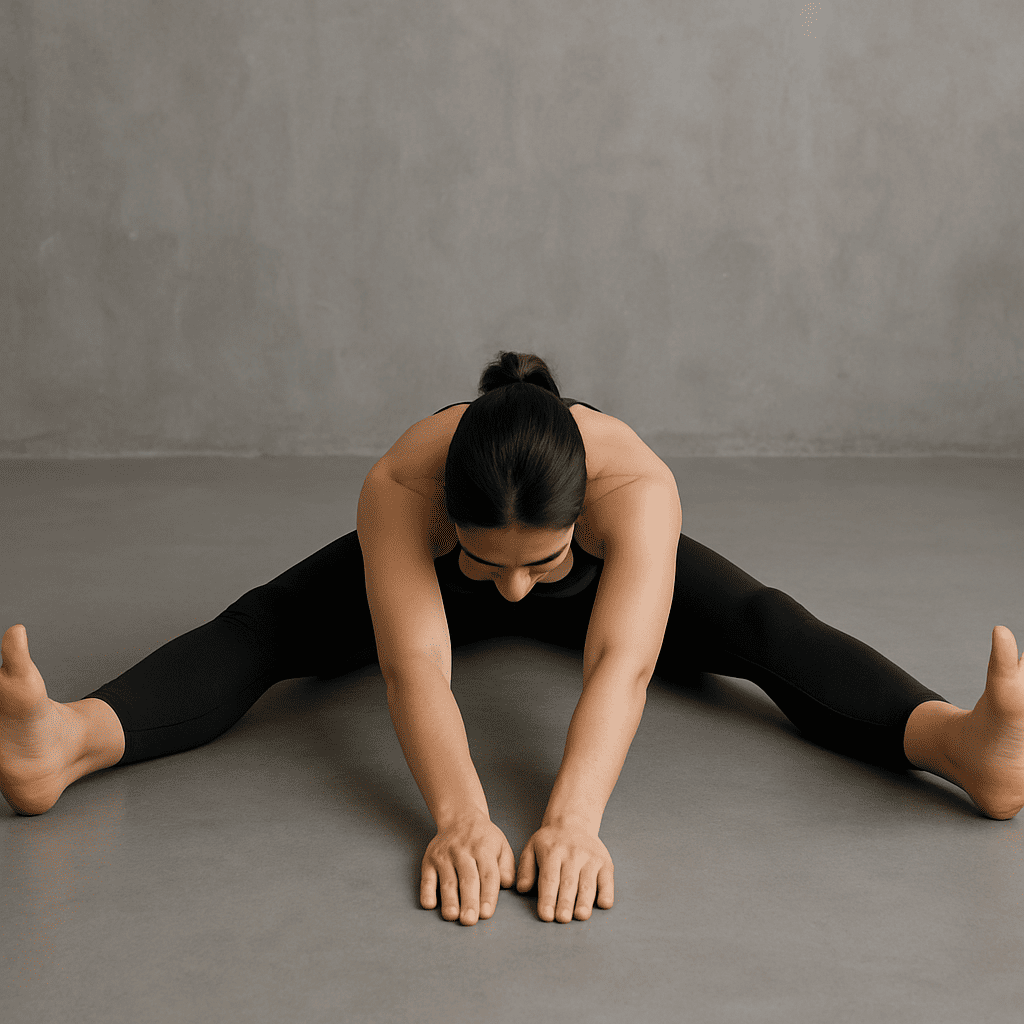16 de May de 2025
Straddle Sit: Exercise Guide, Tips and Benefits
The straddle sit is a foundational flexibility and mobility exercise used across gymnastics, yoga, martial arts, and general fitness. By sitting with legs spread wide and maintaining upright posture or reaching forward, the movement stretches the inner thighs, hamstrings, hips, and lower back. It’s ideal for athletes aiming to improve range of motion, core engagement, and postural strength.
What Is a Straddle Sit?
A straddle sit involves sitting on the floor with your legs spread apart into a wide ‘V’ shape while keeping the spine long and upright. It can be static (held as a stretch), dynamic (with reaches or pulses), or active (engaging the muscles to hold a specific position like in L-sits or gymnastic holds). This position improves hip opening, hamstring flexibility, and total-body awareness, making it a staple in many strength and conditioning routines.

How to Do a Straddle Sit Properly
- Sit on the floor: Extend your legs into a wide ‘V’ position.
- Engage your core: Keep your spine upright and avoid rounding the back.
- Flex your feet: Point toes upward to engage hamstrings and avoid internal rotation.
- Reach forward or side-to-side: Hinge from the hips—not the spine—for deeper stretches.
- Hold or move dynamically: Breathe deeply and maintain tension in the legs.
Tip: Place a folded mat or yoga block under your hips if you’re tight in the hamstrings—it helps tilt the pelvis forward and support posture.
Muscles Worked by Straddle Sit
- Adductors (inner thighs): Primary stretch target.
- Hamstrings: Especially when reaching forward.
- Hip flexors and rotators: Support pelvic alignment.
- Core and spinal erectors: Maintain upright posture.
- Calves and ankles: Stabilized during dorsiflexion.
Benefits of the Straddle Sit
- Improved Flexibility: Especially in hips, hamstrings, and inner thighs.
- Better Postural Control: Teaches upright alignment from the pelvis.
- Enhanced Mobility: Useful for athletes requiring lateral or wide stances.
- Foundation for Advanced Skills: Prepares the body for splits, L-sits, or straddle presses.
- Recovery and Fatigue Management: Promotes blood flow and active recovery after intense training.
Common Mistakes to Avoid
- Rounding the Spine: Always hinge from the hips and elongate the spine.
- Leaning Too Far Too Soon: Avoid forcing the stretch—let it progress gradually.
- Letting the Legs Collapse Inward: Maintain active leg engagement with toes pointed up.
- Holding Your Breath: Deep, calm breathing supports deeper flexibility.
Variations of the Straddle Sit
- Seated Forward Fold in Straddle: Hinge at hips and reach forward.
- Side Reaches: Lean laterally toward one leg while maintaining square hips.
- Active Straddle Hold: Lift legs off the floor while holding the position for core activation.
- Wall-Supported Straddle: Sit with back against the wall to ensure posture.

How to Include the Straddle Sit in Your S&C Workout
The straddle sit is best used in warm-ups or cooldowns, especially before or after lower-body or lateral movement sessions. Hold the position for 30–60 seconds, repeating 2–3 times. Pair with glute bridges, hip openers, or core activation drills. It’s also ideal during deload weeks or mobility sessions to complement intense strength work and reduce fatigue.
FAQs About the Straddle Sit
What is a straddle sit?
A seated flexibility position where the legs are spread wide apart in a ‘V’ and the torso remains upright or folds forward.
Is straddle L sit easier?
For many, the straddle version of an L-sit is slightly easier because it provides more balance and reduces compression on the hips and hamstrings.
What muscles do straddle sits work?
Primarily the adductors, hamstrings, core, and spinal erectors; they stretch and strengthen simultaneously when held actively.
How to do a straddle sit for beginners?
Start with a moderate leg spread, elevate the hips on a cushion, and maintain a tall spine. Gradually increase the range as flexibility improves.
Why can’t I sit in a straddle?
Limited hip or hamstring mobility, tight lower back, or pelvic tilt restrictions can all make the position difficult. Regular mobility work will help.
The straddle sit is a foundational movement for building flexibility, core control, and hip mobility. Whether you’re training for splits, improving your squat depth, or managing training fatigue, incorporating the straddle sit into your strength and conditioning routine will support better movement and injury prevention.
